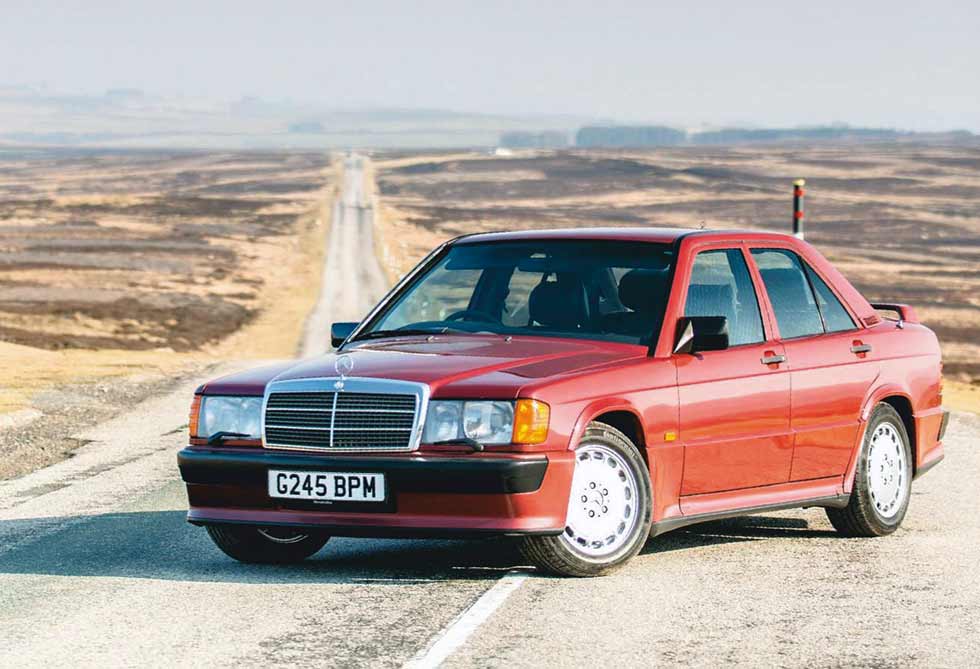
Stuttgart’s sizzling saloon is an icon – but can it still deliver the goods on Durham’s finest roads? Merc’s road racer… Why the world-beating 16-valve Benz hasn’t sat on its laurels. The tip of the Mercedes-Benz racing spear had a chequered history but can it take pole in the Pennines? Words John-Joe Vollans. Photography Adam Shorrock.
GREAT DRIVES DTM TO BPM – JJ heads to Durham to see whether the Mercedes-Benz 190E 2.5-16 still dazzles on some of the UK’s finest driving roads.
Is the Mercedes-Benz 190E 2.5-16 a star on Durham’s moor top roads
The intense rivalry inherent to top-level motorsport makes or breaks a car. For every pole position and win, there are countless hours of effort behind the scenes. Every tenth of a second shaved from a lap time is the difference between a champagne shower or an early bath. In the maelstrom of competition, knowledge is as important as budget, and in the late 1980s Mercedes-Benz were rich in both.
70 UK cars left
WHAT TO PAY
Concours £30,000
Good £25,000
Usable £15,000
Project £8000

The W201 190E 2.3-16 had already proved itself. Setting distance records at the Nardo circuit in Italy in August 1983 showed it to be both reliable and fast. Two of the three cars that entered broke three world records when they crossed the line 201 hours after setting off, having covered over 31,000 miles at an average speed of 153.4mph. This was an entirely new model that was yet to go on sale, remember.
‘ITS ABILITY TO CARRY SPEED IN THE BENDS REMAINS PRODIGIOUS’
The DTM championship was the next destination for the 190E after Audi upset the apple cart with the quattro, effectively ruling out rallying. In competition the 190E 16 valves would prove serious contenders. Runner-up titles came in 1986 and once again in 1988, though outright victory proved elusive.
The hard work eventually paid off in 1992. AMG-Mercedes-Benz took 16 race wins that year with Klaus Ludwig netting the driver’s title.
Impressive, no doubt, but the 190E’s last competition win was nearly 30 years ago. Does it feel its age now? Did all of that motorsport development trickle down to the road car? Only one way to find out… get one out on some great Pennine roads.
‘I CAN’T HELP BUT SNEAK A SIDEWAYS GLANCE AT THE FIST-BITINGLY GORGEOUS COSSIE’
Homologation special. Two words that make any petrolhead’s ears prick up. I’ve driven a few and they can be life-affirmingly brilliant. However, there’s often a downside. The solitary purpose of these cars was to introduce new technology to the race track or rally stage. When you’re enjoying a thrash down your favourite empty B-road these tweaks offer a thrill that’s beyond compare. But when you’re stuck in traffic or just want to nip to the shops, they can quickly become trying on your patience. If only there was a race-inspired road car that didn’t require much in the way of a compromise…
Say hello to the 190E 2.5-16. This 190E is on loan to us from Silverwood Cars in Durham. Phil and his team operate out of a farm that’s been transformed into something of a palace to all things petrol-powered. It’s one of those places where the door swings open and you know you’ve come to the right place. There’s a stunningly varied mix of metal in here, but as sales manager George Craven gives me the tour I can’t help but sneak a sideways glance at the fist-bitingly gorgeous Almandine Red ‘Cossie’ sat in pride of place. This car was family owned from new until the Mercedes-Benz technician who serviced it bought it off them. He in turn sold it to one of the head mechanics at Group A touring car specialists AM speed. It’s safe to say that it’s led something of a charmed existence, but nor is it any sort of garage queen, having covered 81,000 miles in the three decades since it left Stuttgart.
Like any good salesman, George knows when to stop talking. He can see that I’m itching to get out on the road and duly supplies me with the keys. Popping the door, I’m greeted by a check pattern that hints at tartan on the door cards and seat centres.
Scottish somehow meant sporting in the 1970s and 1980s. I’m blaming Jackie Stewart. It looks period perfect in here, right down to the cassette deck. Other than the aforementioned trim however, it’s like sitting inside a coal seam. Everything is black or a shade thereof. Even the factory wood veneer panel around the gearstick has been given a dark crackle finish. Typically Teutonic so far In unfathomable 1980s Mercedes-Benz fashion the key is to the left of the steering wheel with the single column stalk for all other functions placed to the right. You quickly get used to it. The instant the key is turned, yellow needles on the dash – and on the additional three VDO gauges in the centre console – spring to attention. The engine isn’t nearly as urgent. A few prods of the throttle see the revs raise up the tachometer in a lazy fashion. It’s not the immediate hair-trigger DTM response I was hoping for. Then again, this is a big four-cylinder with a lengthy stroke.
‘FINALLY THIS MERCEDES-BENZ GIVES ME A GLIMPSE OF THE RACER WITHIN’
Refinement was Stuttgart’s highest priority even with this road racer, but I can’t help wishing for a bit more theatre.
Following the three-pointed star westward from Durham towards the Pennines this 190E proves every bit as effortless as its larger E- and S-Class siblings. Overall vision is superb (especially looking forward) with slim A-pillars and a huge windscreen. The deep C-pillar doesn’t impede blindspot vision and looking in the mirror reveals the subtle boot-mounted spoiler. It’s all very comfortable and easy, in other words, exactly as expected.
Out of the confines of the suburbs and onto The A68 I can begin to feed the engine some much needed revs. In 1988 the over-square 2.3-litre M102 engine was stroked from 80.25mm to 87.20mm to give a displacement of 2464cc.This ‘new’ engine has a slightly different character to the early2.3-16’s. It makes 10bhp more and yet produces its peak 192bhp nearly 600rpm higher up the rev range. Crucially, torque – something of a twin-cam four’s weak spot– remained unchanged but was delivered 1000rpm higher. To put it another way, the 2.5-litre forces you to work it hard to get the best from it. Fine if that’s your thing (it is mine) but if you like overtaking effortlessly in any gear then there is a chance that you will find this 190E pretty under whelming.
While I’ve been pondering the relative Advantages of the 2.3-litre versus the 2.5-litre I’ve failed to notice that the road has been steadily climbing. Turning off the A68 I’m presented with a moor-top vista par excellence. Running along the side of a reservoir there’s a seemingly endless strip of tarmac stretching to the horizon in an arrow straight line. Best of all, there’s not another car in sight. Time for some fun… I hold onto second gear all the way to 7000rpm and have something of an epiphany. Off the throttle and giving the short-throw gearstick a nudge straight up, I’ve got third. The dogleg pattern that was frankly irritating at car park speeds now starts to make sense. Throttle hard down again and the intake roar makes itself known over the background din. Beyond 4000rpm that yellow needle on the rev counter decides to dive dramatically for the red-marked end zone. Finally this Mercedes-Benz gives me a glimpse of the racer within.
Reaching the upper range of the tacho again in third gear sees some pretty silly figures appearing on the speedo, so I back off a bit and give myself time to think. Short shifting into fourth instantly calms the M102 down and it resorts to its previously civilised demeanour. Perhaps it’s because I own a 190E manual and am used to its quirks but I’ve never really had a problem with the shift quality. I will concede that an E30 M3, which uses the same Getrag five-speed transmission, has the sweeter shift. But if you’re deliberately a little less aggressive and more precise with this Mercedes-Benz linkage then it allows you to shift nearly as quickly, if not quite as satisfyingly.
It turns out that this moor-top start/finish straight does have an end and it comes in the form of a few nice bends. At one end is a tight 90-degree left that’s well sighted on entry. It falls away as it twists too. Think County Durham’s answer to the Corkscrew at Laguna Seca, if you squint very hard…
Anyway, it’s ideal to test this car’s chassis. Unlike that famous California circuit, there’s a stonewall on the exit of this bend that looks ready to ruin my day if I get it wrong.
My first run shows that’s highly unlikely to occur. This 190E brakes progressively and dives a little to let you know that the weight has left the back and gone onto the front axle. As I begin to turn in, the box steering doesn’t give the same 1:1-ratio feel as a rack and pinion setup but there’s still enough feedback to decipher the grip. It leans a little more than you’d expect for a performance saloon, in truth, but its kept sensible by the roll bars.
As I reach the apex and release some lock, the power is easy to feed back in gradually and the 2.5-16 shoots out of the bend with only a mild protest from the tyres to tell me when I’m approaching the limit. This thing is really impressive.
The other end of the straight ends in a corner that couldn’t be more different than the first. This left-hander crests a summit with its exit invisible somewhere over the horizon. The 190E’s completely balanced composure has filled me with confidence, yet this plunge into the unknown still requires a few practice runs. Gradually building speed with each pass, the 2.5-16 is more than happy to grip, grip and then grip some more.
Eventually the tyre sidewalls complain with a chirrup but unless you’re doing anything silly with the steering or the pedals the 2.5-16 proves perfectly controllable. It’s quick too. Straight-line performance won’t worry anything modern sporting an RS or GTI badge but its ability to carry speed in the bends remains prodigious. After only a few hours with this 190E it’s clear why it proved so competitive on the race tracks of Europe.
Serious driving mood engaged. Seriously slippery silhouette. The 2.5-litre means a long stroke for JJ. Darker than JJ’s internet history. Mutton casserole anyone? Very few were painted Almandine Red. Sportline trim not standard but looks ace. 15-slot alloy wheels subtle yet sporty. Open roads are 2.5-16’s happy place.
The Modern Classics view
Without the 16-valve 190Es we wouldn’t have had the BMW E30 M3. At least, not in the form we’re all familiar with. The 2.3-16 was unveiled a full two years before the M3 and it’s no coincidence that the BMW was powered by a very similar 2.3-litre four-cylinder engine. OK, so DTM regulations of course played a part, but BMW also recognised how spot on the 190E 2.3-16 concept was. It’s impossible to mention one without the other. Yet for all they share they remain very different.
The later 2.5-16 offers mature performance. Despite the bodykit and spoiler, dogleg manual transmission and deeply scultpted sports seats it remains eminently usable. At high speed the cabin is whisper-quiet and not even a quiver of vibration from the driveline is permitted.
The fixtures and fittings are so secure they feel as if they’re load-bearing, and everywhere you look around the car there are always three clips, fasteners or bolts where others would have made do with one. This was a car built for longevity.
Despite all its refinement, however, the 190E 2.5-16 W201 can shed this persona as soon as you take it over 4000rpm. Once in this zone this 190E discards its grown-up character quicker than kids shed their uniform on the last day of school. Flat out, the 2.5-16 rewards the driver with a lively yet delicate balance that’s not as knife-edged as the M3 E30 or as blunt as an Audi 80.
This could be the ultimate real world homologation special. There’s no comfort compromise yet it still provides vast levels of driver engagement. Win, win then.
MERCEDES-BENZ 190E 2.5-16 W201
Engine 2464cc, 4-cyl, DOHC
Transmission RWD, 5-speed manual
Max Power 192bhp @ 6800rpm
Max Torque 173lb-ft @ 5500rpm
Weight 1320kg
PERFORMANCE
0-60mph 7.7sec
Top speed 143mph
Economy 31.4mpg
WHERE WE WENT
Heading west from Durham towards the North Pennines National Park we joined the A68 at High Stoop and headed North. There are some fast and well sighted bits of the A68, but it’s busy so we took a left towards Waskerley and entered the Pennines proper. The stretch along the unmarked B-road between Waskerley and Stanhope is a joyous and largely traffic-free moor-top road. We particularly enjoyed the near arrow-straight stretch of the B6278 along the side of Smiddy Shaw Reservoir. If you want something tighter and more technical then the little cattle-gridded B-road to Blanchland provides many grins. The best bit about this whole area is that it’s largely traffic-free but do watch out for stray sheep and farm traffic.
I BOUGHT ONE RHYS MANGAT
There isn’t a 190E W201 fan in the UK who isn’t aware of the Mangat 190Es. ‘For as long as I can remember there’s been a 16V in the garage. There’s really very little out there that compares as an all-rounder. There are faster and better-handling cars but few can combine both with a level of build quality on a par with this Mercedes-Benz. They’re cheap to run too. A classic insurance policy costs just £250 per year and road tax is just £20 a month. That being said, owning one isn’t all good news. Prices have shot up recently and as a result secondhand parts are getting expensive. Most are still available from MB though. Suspension spheres can fail but generally these are hugely reliable cars.’








